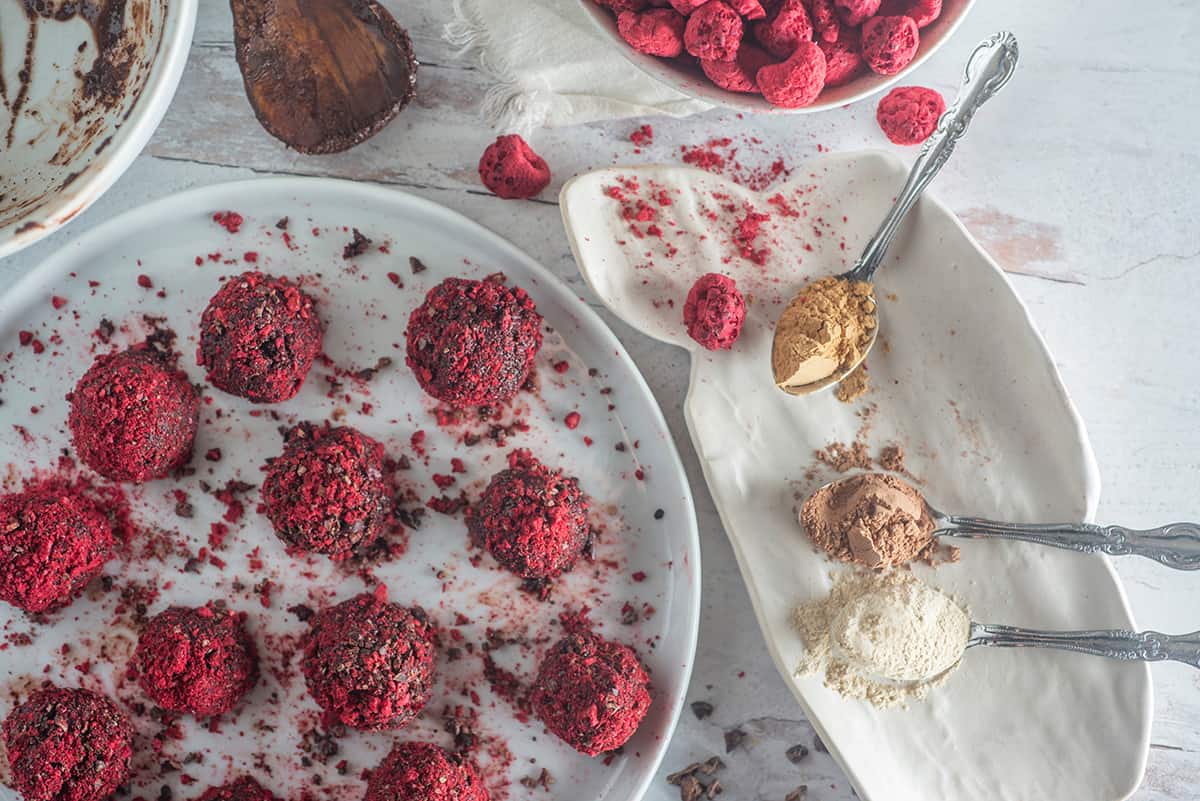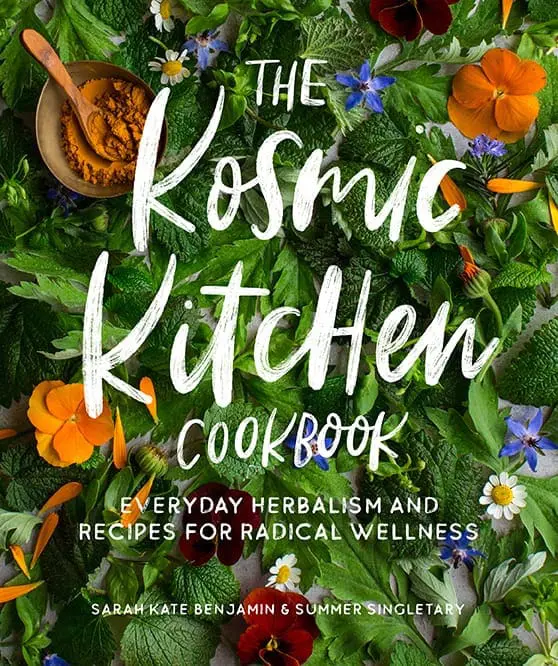Written and Photographed by Paulette Phlipot
—
Stressed? Overwhelmed? Easily distracted? Have you thought about enlisting the help of an adaptogen?
According to herbal medicine, an adaptogen is “a natural substance considered to help the body adapt to stress and to exert a normalizing effect upon bodily processes.” This category of herbs, fungi, and berries piqued my interest a few years back when I noticed recipes and skincare products boasting adaptogens. I was already familiar with the common ones, like turmeric, ginseng, nettles, and maca, but not with schisandra berries, eleuthero, rhodiola, and bacopa. To be honest, I didn’t quite understand why these plants, fruit, and mushrooms earned such rockstar status. So, armed with a pile of library books in hand, my quest began to discover the benefits and possible side effects of these elusive healers, while figuring out how to add them safely into my family’s meals.
In my studies, I learned that the Soviet Union takes the claim for creating the classification “adaptogen.” Russian scientists were on a quest to find substances that would improve the performance of both their military personnel and their athletes. They trimmed their focus to specific herbs that increased resistance to stress. Many of these herbs’ uses date back thousands of years to ancient Chinese and Ayurvedic medicine, but were never classified until Nikolai V. Lazarev, a Soviet toxicologist and pharmacologist, created the word “adaptogen” from the Latin word “adapter,” which means “to adjust.”
Adaptogens respond moment to moment to our physiology. If you are overstimulated, they calm you. If you are overtired, they provide needed energy.

So, maybe you want to boost your speed skinning up the mountain, improve your athletic focus, build immunity, or better handle holiday stress? Then, consider including adaptogens to your mix. Adaptogens are available as teas, extracts, capsules, powders, and tinctures, as well as in the whole form. I prefer finding creative ways to incorporate these powerhouses into my family’s meals and snacks. (Plus, it’s the safest way to consume them.)
Before you start pouring them by the spoonful into your coffee or morning smoothie, though, it is important to check with your healthcare professional, especially if you are on medications, have liver or kidney concerns, or are pregnant or breastfeeding. And do remember, too much of a good thing does not always mean better. Also, be mindful of the time of day you enjoy adaptogens, as some can be stimulating, like ginseng and rhodiola. Since adaptogens have the ability to affect the endocrine and hormonal systems, don’t dump them on your teen’s nightly bowl of popcorn, either. (Although maca and honey over popcorn does taste great!) In fact, use care when giving adaptogens to children in general, as their endocrine systems are still developing.
Although adaptogens can be life-changing, it is important to do your homework and be patient. This is not a one time, quick fix. The effects of these potent herbs and fungi are subtle and gentle and build up over time. Discuss a specific protocol with your natural healthcare provider for best results, and try creating delicious recipes that include adaptogens, no capsules needed.
IMMUNITY

Miso Immune Soup with Astragalus Balls
—
Serves 2 to 3; makes 12 balls.
—
In Eastern medicine, astragalus is known as a chi, or energy, tonic. Astragalus root strengthens digestion and supports the immune system. Use it in times when your body feels run down.
—
For the Soup:
4 to 6 cups water
1 burdock root, sliced
2 cups fresh shiitake mushrooms, chopped
1 bunch kale, shredded
1 package firm tofu (14 ounces), cubed
4 Miso Immune Soup Balls *recipe below
1 carrot, thinly sliced
1 bunch green onions, thinly sliced
- In a saucepan, heat the water on medium-high until it comes to a boil.
- Add the burdock root and shiitake mushrooms, reduce the heat to medium, and allow the mixture to simmer, covered, for at least 15 minutes, or until veggies are tender.
- As the burdock root and mushrooms cook, add in the kale and tofu, and allow to cook for the last five minutes.
- Just before you turn off the heat, add the Miso Immune Soup Balls one by one to taste, using a whisk to quickly emulsify.
- Divide the soup between the bowls and top with the carrot and green onion slices.

For the Balls:
¼ cup dried wakame seaweed
¼ cup black sesame seeds
2 cups miso paste
2 tablespoons astragalus powder
1 3-inch piece fresh ginger, grated
- Place the seaweed and sesame seeds into a food processor or coffee grinder. Pulse until roughly ground.
- In a large mixing bowl, and using a wooden spoon or spatula, combine the mixture with the miso, astragalus powder, and ginger.
- Using the palms of your hands (ideally wet to prevent sticking), roll the paste into 2-inch balls and place in an airtight container with parchment paper to separate the layers. You will use them like bouillon cubes.
- Store in the freezer for up to 3 months.
* Recipe adapted from The Kosmic Kitchen Cookbook, Roost Books, 2020
ENDURANCE & ENERGY

Enhance my Athletic Performance Truffles
[Adults Only]
—
Makes 12
—
These truffles are a powerful combination of performance-enhancing adaptogens. They’re designed to help an athlete perform at his or her peak, gain incredible stamina and endurance, and recover at an optimal rate.
—
¼ cup coconut oil
½ cup raw cocoa powder
¼ cup maple syrup
½ teaspoon Himalayan pink sea salt
¼ teaspoon ashwagandha powder
¼ teaspoon cordyceps powder (can sub chaga)
¼ teaspoon ginseng powder
¼ teaspoon rhodiola rosea powder
1 tablespoon almond or cashew milk
Toppings:
2 tablespoons cacao nibs, crushed
2 tablespoons freeze-dried raspberries, crushed
- In a small saucepan, warm the coconut oil until just melted. Transfer to a medium bowl.
- Add the cocoa powder, maple syrup, salt, and all adaptogen powders. Stir to combine.
- Add in the nut milk. Transfer the mixture to the refrigerator and chill, covered, for 10 minutes.
- With wet hands, roll the sticky mixture into 12 balls, then roll in the toppings.
- Place on a parchment-lined tray and transfer to the refrigerator for at least 20 minutes before eating.
Note: You can source most powders (in capsule or bulk) at Jackson Whole Grocer, Barrels and Bins, or at starwest-botanicals.com.
* Recipe adapted from Adaptogens: A Directory of Over 70 Healing Herbs for Energy, Stress Relief, Beauty, and Overall Well-Being, Chartwell Books, 2020
GUT HEALTH

Good-For-My-Gut Walnut Spread
—
Makes 1 cup
—
This homemade walnut spread incorporates burdock root and hawthorn berry powders. It’s great on toast, pancakes, and waffles. Burdock is especially great if you’re taking antibiotics: It helps restore the gut back to homeostasis.
—
1 cup sprouted walnuts
2 teaspoons maple syrup
1 ½ teaspoon burdock root powder
1 teaspoon hawthorn berry powder
½ teaspoon ground cinnamon
½ teaspoon Himalayan pink sea salt
1/8 teaspoon ground cardamom
- Add the walnuts to the bowl of a food processor and pulse eight to 10 times to break the walnuts down into smaller pieces.
- Add in the maple syrup, burdock, hawthorn berry, cinnamon, sea salt, and cardamom and blend on high for three to five minutes or until the mixture resembles a nut butter. Scrape the sides, as needed.
- Keep in an airtight glass container for three to five days.
* Recipe adapted from Adaptogens: A Directory of Over 70 Healing Herbs for Energy, Stress Relief, Beauty, and Overall Well-Being, Chartwell Books, 2020
Want to learn more?
If you are new to adaptogens or just trying to remember which adaptogen does what, pick up a copy of Adaptogens: A Directory of Over 70 Healing Herbs for Energy, Stress Relief, Beauty, and Overall Well-Being by Melissa Petitto, R.D. This book is filled with unique recipes for drinks, soups, sauces, and desserts. You will find yourself referencing it often.
The Kosmic Kitchen Cookbook: Everyday Herbalism and Recipes for Radical Wellness, by Sarah Kate Benjamin and Summer Ashley Singletary, goes far beyond simply opening your eyes (and mouth) to great adaptogenic recipes. It’s filled with garden wisdom and life encouragement and is guided by the five elements of Ayurveda: ether, air, fire, water, and earth. This book also includes luscious skincare recipes, too!


